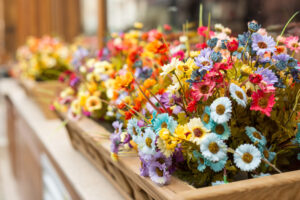 Looking to add a touch of flower to your windows this spring with some window flower boxes? Here are some tips for successfully planting flowers in window boxes.
Looking to add a touch of flower to your windows this spring with some window flower boxes? Here are some tips for successfully planting flowers in window boxes.
Mix and match your florals.
There are a few things to consider as you mix and match plants for interest:
Choose a variety of sizes.
The best window boxes have some dimension to them, and this is best done by choosing a few different flowers of varying heights for each box. You might, for example, plant coleus along the back of your window box for height; begonias throughout the middle of your box to fill it out; and then ivy along the front of your box for something that trails over the edges.
Mix flowers and foliage.
While on the subject of mixing and matching florals, you want to be sure to include a mixture of flowers and foliage as well. This will make for an especially bright window box during the spring that will also be rich in green color through the summer and even fall months.
Look for both broad and narrow leaves.
Finally, your window boxes will look more interesting if they feature varying thicknesses of leaves as well. Look for plants that have broad leaves as well as those that have small, finely textured leaves, and plant them together.
Position flowers according to how much light they need.
Flowers do require varying amounts of sunlight in order to thrive, so it is highly important to verify this before planting flowers in your window boxes. A flower that requires a great deal of sunlight, for example, will do best in a south-facing box, while a flower that thrives in shade would do better in a north-facing box (if you are in the northern hemisphere, that is.) Some flowers need morning sunlight and should therefore be planted in east-facing window boxes, while other flowers prefer afternoon sunlight (you guessed it: west-facing window boxes are best here.) Determine what your flowers will need in terms of sunlight exposure and position your flowers in window boxes accordingly. And if you only have window boxes on one side of your home, then you’ll need to determine which direction these window boxes are facing and then select flowers accordingly.
Use the right planting medium.
The best planting medium for window boxes is actually potting mix, and you’ll want to make sure it’s lightweight. Mix is better than soil for containers because it contains larger particles, can hold more air, and is more water retentive—all important things to consider when you are planting in a container rather than in natural garden soil.
Ensure proper drainage.
It’s also important to ensure that excess water will be able to drain from your window boxes. Most window boxes for purchase will come with holes already drilled into the bottom, but if you are making window boxes yourself, you will have to drill these holes. Don’t forget to punch holes in any plastic liner you might be using on your window boxes. Add pea gravel to the bottom of your window boxes as well to ensure proper drainage.
Avoid transplant shock.
It’s best to use flowers and plants that come in small nursery containers in order to avoid transplant shock. As you plant, you should also be sure to loosen the roots of your nursery plants and scatter fertilizer throughout your potting mix, both of which will also help to reduce transplant shock.
